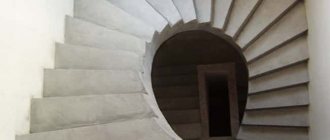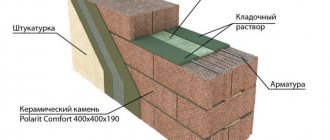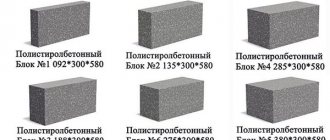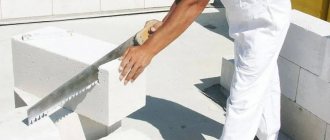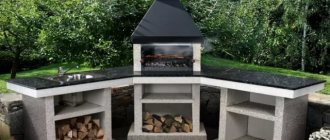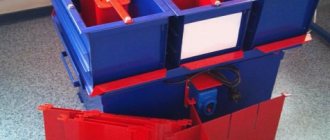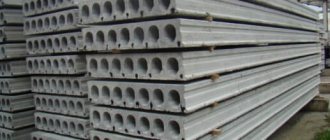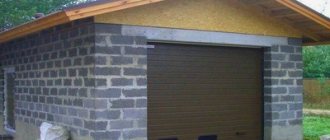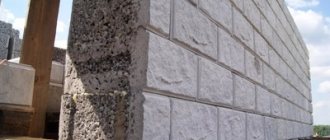What are the advantages of expanded clay concrete
Partitions made from expanded clay concrete hollow blocks have a number of advantages related to the characteristics of the material from which they are made:
- This material is noticeably lighter than concrete (has a lower volumetric weight), which greatly facilitates the installation of structures based on it.
- In terms of mechanical strength, such blocks are comparable to their concrete counterparts, and are not inferior to them in terms of resistance to cracking.
- The use of expanded clay concrete is justified by its fire resistance (with strong heating, the load-bearing capacity of the products does not decrease).
- Buildings made from such blocks are distinguished by good vapor permeability (the wall of them “breathes” to its entire depth).
Important: Expanded clay concrete has excellent heat-insulating and sound-absorbing properties.
- Products made from it are distinguished by enviable frost resistance and can withstand about 100 cyclic freezing followed by thawing.
- The environmental friendliness and low cost of expanded clay concrete blanks are especially in demand in the construction of residential building structures.
It is also important that hollow expanded clay concrete partition blocks can be made directly on the construction site (for this, simple equipment will need to be installed next to the object being built).
Builders note their good adhesion to most finishing materials, including ceramic tiles, laminated plastic, plaster or natural wood.
Types of expanded clay concrete blocks
Blocks for partitions made of expanded clay concrete are usually classified according to the following parameters:
- by density, which determines the load-bearing capacity of the product;
- by appointment;
- according to the shape and structure of the material
The simplicity of manufacturing expanded clay concrete blocks allows you to set parameters based on the purpose of each specific type of product. When considering partitions, the shape and size of the block are especially important.
In accordance with these parameters, a simple expanded clay concrete partition block can have the following designs:
- Pozogrebnevy.
- Straight.
- L-shaped (angular).
- Simple.
In addition, the blocks can be solid or hollow, and also designed in the form of lintels and crossbars. A large selection of shapes and sizes of these products allows you to assemble partitions of any complexity from them.
According to their purpose, they can be wall or partition, ventilation and foundation (their scope is determined by the name of the product).
What are expanded clay concrete blocks according to GOST
Expanded clay concrete is classified as lightweight concrete. A porous material, expanded clay, is used as a filler. These are round granules made of baked clay. The composition of expanded clay concrete is cement, sand, expanded clay and water. When preparing the mixture, more water is poured than in ordinary heavy concrete, since expanded clay is hygroscopic and absorbs liquid. When producing blocks, the finished mixture is poured into molds, left until initial hardening, after which they are removed from the mold. In principle, the blocks are ready, but they cannot be used until they reach their design strength.
A house made of expanded clay concrete blocks can be built quickly
There are two technologies for bringing products to normal strength at the factory - in an autoclave and by vibration pressing. In the first case, the blocks are sent to an autoclave, where the material is treated with steam under pressure. This makes expanded clay concrete blocks more durable. The second method is vibration with simultaneous pressure. When vibrating, all voids disappear, the solution becomes more homogeneous and fluid, enveloping each of the expanded clay granules. The result is high strength indicators.
In artisanal production, the blocks are simply left to “ripen.” In theory, it takes at least 28 days until the concrete gains strength. But they can sell it earlier so as not to take up space. Nobody guarantees durability.
Round granules of expanded clay can be seen on the surface of the block. Depending on the brand, they can be of different sizes, in larger or smaller quantities
The fact is that for cement to gain normal strength, it is necessary to create a certain heat and humidity regime. In this regard, expanded clay concrete is more capricious than ordinary concrete. Due to the high absorption capacity of expanded clay, it can take up too much water. And the liquid will not be enough for the concrete stone to gain strength and not just dry out. Therefore, it is advisable to water the finished blocks and cover them with film at least for several days after production. They cannot be kept in the sun and the temperature should not be lower than +20°C. Otherwise, expanded clay blocks will never gain the required strength and will crumble even under light loads and impacts.
When it comes to price, factory units are more expensive. But still. If you are building a house, and not a utility block or barn, you should not save money and buy “garage”-made blocks. Quality is a big question here.
Markings and characteristics
For the production of expanded clay concrete blocks, expanded clay and Portland cement are used, processed using the well-known pressing method on a vibrating table. In accordance with GOST 6133-99,10180-90 and 12730.1-78, according to their mechanical characteristics, they belong to the class of lightweight concrete.
According to this document, the following markings are used to designate them:
- Wall products are designated by the symbol “C”.
- The blocks from which hollow partitions are made are marked with the letter “P”.
- Front and ordinary (used for finishing) - “L” and “R”, respectively.
- Corner block blanks are designated as “UG”.
The key technical parameters of these products also include the density of the material, marked as “D”. This indicator for most types of expanded clay concrete blocks is in the range from D500 to D900.
The products included in this range differ not only in their density, but also in their thermal conductivity and weight. For example: with the dimensions of an expanded clay block of 390x190x180 mm with a density of D500, it weighs approximately 12 kg, and a product with a density of D900 weighs about 17 kg.
Expanded clay concrete blocks can reach 40 cm in length (with a width of about 19 and a height of about 20 cm).
Installation of a partition made of expanded clay blocks
Mortar for expanded clay concrete
For laying expanded clay concrete blocks, either purchased powder mixtures or solutions prepared independently before starting work are used. In the first case, when mixing them, you should follow the instructions given on the packaging.
Please note: A concrete mixer located close to the place where the partitions are laid is best suited for these purposes.
The basis of home-made solutions is cement of the highest grade (not lower than M400), to which sand, cleared of lumps and debris, is added in the required proportion. The choice of the ratio of components in the solution depends on the required strength of the masonry (under normal conditions it is selected 1 to 3).
The cold water used in the mixture is pre-filtered (cleansed of large particles of debris) before use. Its content in the finished mixture should not exceed 25 percent of the total mass.
When preparing the solution yourself, experts advise adhering to the following rules:
- The composition is prepared immediately before use (due to the possibility of it hardening).
- To do this, it is more convenient to use a small volume concrete mixer.
- First, a little water is poured into it, and then the amount of sand and concrete calculated for one batch is poured.
After the composition is thoroughly mixed, the remaining portion of water is added to it.
Preparing the base
Before laying expanded clay concrete partition blocks, a base is prepared, which means a waterproofing layer laid over concrete. For these purposes the following can be used:
- ordinary roofing felt;
- stekloizol;
- any other laid roll material.
Before laying the insulation, the work area should be cleared of debris and remnants of the old coating, and then leveled with a layer of screed. After this, a layer of cement mortar is applied to the concrete, on top of which waterproofing is laid.
If it is necessary to equip a base for a partition, bricks or FSB are used as a base.
How to lay expanded clay blocks correctly
Before starting installation, you should prepare a set of blanks of already adjusted size and place them next to the work site. After this, you will need to choose a masonry scheme: half or one block (when constructing partitions, the second option is usually used).
The technology for laying expanded clay concrete blanks involves the following sequence of actions:
- First, corner (beacon) blocks are installed.
- Then a string is stretched between them to control the correctness of the masonry.
- After this, be sure to lay the first row of blocks on the mortar (not glue!).
Important! You should start from the highest point of the base, leveling the voids by increasing the width of the gap (seam).
- The second and subsequent rows are laid with a slight offset, and the thickness of the seam should be at least 1 cm.
Upon completion of the next row, it is necessary to check the evenness of the laying, since due to uneven sizes of the blocks it may be disrupted. We should not forget about the reinforcement of the structure, which should be done with a special mesh every 3-4 rows.
Dressing
When installing blocks, first of all you should worry about the connection of the partition with the supporting structures of the building, which is carried out over the entire thickness of the walls. To organize it, holes are drilled into them, into which reinforcing bars are then inserted along with the mortar.
When laying expanded clay concrete partitions and piers, ligation between rows is required, ensured by shifting the blocks in each row by half their length. With a standard size of a typical block blank of 38 cm, this will be approximately 19 cm.
Bandaging allows you to increase the strength of expanded clay concrete structures by distributing the load evenly over their entire area. This method has always been used to reinforce not only light partitions, but also other building structures.
Doorway
When constructing expanded clay concrete partitions, it is necessary to build in door blocks, for the design of which it is advisable to use tongue-and-groove panels. If available, you will need to perform the following operations:
- Securely fasten the side walls, for which a reinforcing rod is used, laid in niches on the sides of the opening.
- Then their sections are filled with a solution, on top of which a pre-prepared metal jumper is laid.
Additional information: For solid expanded clay concrete blanks, reinforcement is not necessary; It’s enough just to align their edges.
For hollow blocks, special jumpers are provided that fit perfectly with them and are hidden in the structure of the pier.
Completion of wall construction
Upon completion of the construction of the expanded clay concrete wall partition, it is not built right up to the ceiling. Between the ceiling and the top row of blocks it is necessary to leave a gap of about 1-1.5 cm (this gap is subsequently filled with polyurethane foam).
The working gap is necessary in order to prevent deformation of expanded clay concrete partitions due to possible vibrations of the ceilings.
How to build partitions from expanded clay concrete
The arrangement of partitions is no different from the technology of constructing walls from any other materials. Let's consider the question in more detail.
Base
Although the expanded clay concrete partition block is relatively lightweight, it still requires a foundation. You can do without it only if the masonry rests on a floor made of reinforced concrete slabs.
True, it is not necessary to make a continuous strip foundation; a columnar one, with a connection from foundation beams or even ordinary lintels, is also sufficient. We also must not forget: although the material is not afraid of moisture, we still install waterproofing, otherwise the walls in the house will be constantly damp.
Monolithic partitions
Construction made of monolithic expanded clay concrete
Everything is done in exactly the same way as when constructing structures made of heavy concrete.
- We build formwork. Due to the low density of the material, it expands less, shields and racks are easier to make.
- Be sure to provide a connection with the rest of the walls. It is enough to simply glue steel rods at the points of contact, in increments of 0.2-0.3 meters along the axis of the future partition. It’s even easier to install self-expanding anchors with the same spacing. They should also protrude by 0.2-0.3 meters.
Advice. If, when building external walls, you know exactly where the partitions will be located, install connections in advance in the masonry.
- If we are going to reinforce a wall, then we lay reinforcement mesh. Be sure to put clamps on it to provide a protective layer of concrete. Moreover, for better preservation of the metal in the porous material, we make it a little larger than in heavy concrete - not the standard 3 cm, but 4-5 cm.
- If necessary, we attach embedded parts to the mesh.
- Even if our expanded clay concrete partition does not have reinforcement at the openings, especially large ones, we still need to lay reinforcement bars or install standard expanded clay concrete or reinforced concrete lintels.
- We lay concrete. It is clear that instructions are not needed for this operation. As with any concreting, the process must be continuous, since the points of contact of the hardened mixture with freshly prepared concrete weaken the structure.
Advice. Do not neglect adding plasticizer to the concrete mixture. It will facilitate installation, reduce cement consumption and increase strength.
- When laying, be sure to compact the concrete. It is best to do this with submersible vibrators. At home, you can get by with ordinary tampers.
- Once the formwork strength has been achieved (3-7 days), we remove the formwork and until it reaches brand strength (24 days) we take care of it as with ordinary concrete. We wet the surface and, if possible, cover it with film to reduce water loss by evaporation.
If work is carried out in the cold season in an unheated room (which is undesirable), we apply the rules of winter concreting, add additives, insulate and (or) heat the wall.
Laying partitions from blocks
Tongue-and-tongue expanded clay concrete blocks
To build a partition, you can use either a factory-made or a self-made expanded clay concrete partition block. Moreover, the material is lighter and larger in size than ceramic or sand-lime brick, so it is easier to work with and the construction of the wall is faster.
You can simplify the work even more by using tongue-and-groove blocks; these are the ones shown in the photo above. They (which is why they have such a name) have ridges and corresponding grooves on their surfaces; working with them is reminiscent of assembling a children's construction set. A wall made of such blocks will be smooth even with a low-skilled mason.
In addition, the masonry is more durable, since the blocks are connected to each other not only with mortar or glue, but also fixed due to the geometry of the grooves and ridges.
Mortar or glue?
Masonry with glue
Expanded clay concrete blocks for partitions can be laid either with glue or with mortar, so many people doubt which to choose. Definitely better glue. It hardens faster and provides stronger joints. The adhesive layer is thinner, and if the base of the partition is correctly aligned, then you do not need to ensure that each block is horizontal.
When using a solution, misalignment may occur due to uneven thickness of the seams. Therefore, you have to tighten the fishing line and check the position of each block with a spirit level or plumb line. Also, masonry with glue is cleaner, although this is not so important - expanded clay concrete partitions are not made for jointing and are usually then finished with another material.
The only advantage of cement mortar is that it is possible to carry out the laying in a “empty” manner, which holds the plaster better. But today this is not important, since a mesh is almost always used to strengthen the plaster layer.
Advice. Expanded clay concrete is difficult to crack with a mason's hammer. Therefore, if you need a half or a “nine”, cut it with a special circle. Even better, when purchasing the material, purchase the required number of halves.
Masonry requirements
High-quality masonry
To make the partition strong and reliable, you must comply with the following requirements.
- Before starting the cladding, we carefully level the base; the easiest way to do this is with a cement screed, and check it with a laser plane builder (in everyday life it is often called a level).
- Be sure to install waterproofing.
- Do not forget about connections with other walls; we make them in the same way as when constructing a monolithic wall.
- As with masonry from other piece materials, we make dressings for ½ of the length of the block, and on each row.
- It is advisable to reinforce the partition with metal mesh.
- We lay lintels over the openings. For industrially produced hollow blocks, there are special metal ones that are completely hidden in their volume.
- We do not lay masonry all the way to the ceiling. It is necessary to provide a gap to compensate for deformations, subsidence of floors, and vibrations. We leave 10-15 mm, which we will then fill with polyurethane foam.
We will be glad if our short article helped you in creating a partition from expanded clay concrete blocks or a monolith. Not bad, even if we simply expanded the range of your knowledge about building materials, their capabilities and technologies of use.
Mortar or glue
When considering special compositions and mixtures used for laying blocks, you need to pay attention to the following:
- When working with most expanded clay concrete materials, preference is given to special adhesive compositions.
- When laying the first row of blocks, it is best to use cement mortar.
- A special mixture used for laying tiles can be used as glue.
It is important to note that when using an adhesive composition, the quality of installation of expanded clay concrete products only increases.
Block laying options
There are several methods by which walls can be built. It all depends on the purpose of the building under construction and the requirements placed on it. In particular, it is important to determine the thickness of the walls in advance.
- Laying blocks in the box of a building whose walls are as thick as the width of the block. The method is considered ideal for equipping warehouses, garages or barns. The internal surfaces of the walls are sealed with plaster mixtures, the external surfaces are covered with any insulating material. Most often, either mineral wool or polystyrene foam is used.
- Laying walls with a thickness corresponding to the length of the block. Recommended for the construction of small, frequently used buildings (baths, for example). The installation principles are the same, only the insulation layer is laid out thinner.
- Laying blocks in a wall with parallel bandaging of elements and provision of an air gap between them. With this method of construction, the thickness of the walls will be 60 cm. The insulation is laid in layers, and the inside of the room is plastered. The technique is used in the construction of summer cottages.
- Laying two parallel walls at a short distance from one another. The walls are reinforced with reinforcement, and insulating material is laid in the pier.
The last technique is the most difficult. However, its use provides a permanent structure with high thermal insulation characteristics, in which you can live all year round.
The quality of the entire house directly depends on the laying of the first row of blocks.
Monolithic partitions
Monolithic expanded clay concrete partitions are made using standard technology, according to which the pre-prepared mixture is poured into a mold made of special formwork. To obtain the required quality of the external and internal surface, metal fences are added on both sides.
This type of expanded clay concrete products has both disadvantages and certain advantages. Their disadvantage is that production requires bulky formwork, labor-intensive to manufacture and requiring a large number of one-time operations.
Their advantages include the ability to set arbitrary shapes and dimensions during manufacturing that correspond to the structure being built. In addition, monolithic partitions are more durable (compared to a structure made from single blocks).
Please note: To increase the strength characteristics of expanded clay concrete products, their additional reinforcement using known methods is allowed.
Despite all the listed advantages, these types of partitions are used extremely rarely in practice.
Expanded clay blocks for partitions
A wall block made of expanded clay concrete differs from other artificial stones in that it uses baked clay instead of ordinary crushed stone as an inert filler. Such a replacement radically changes the heat and sound insulation characteristics of concrete, expanding the range of its use in construction.
There are three types of wall materials based on their use in construction:
- Structural, having the highest strength and density.
- Structural and thermal insulation.
- Thermal insulation, with the lowest density and strength, but with high heat and sound insulation values.
Read more about the characteristics of expanded clay concrete blocks here.
In particular, expanded clay concrete blocks used for constructing partitions are specifically structural and thermal insulating blocks, with a density of 900-1200 kg/m3. Their compressive strength grade: M25 – M50.
Technical characteristics of expanded clay blocks:
- The internal sealed pores of expanded clay, filled with air, ensure high thermal insulation of expanded clay. The thermal conductivity of expanded clay concrete (k=0.18 W/m*K) is approximately three times lower than that of structural concrete. Sound insulation with a standard thickness of the partition block of 9 cm is 45-50 dB.
- Partition blocks do not experience such temperature changes as external ones, so frost resistance is not critical for them, however, it is quite high - 25-50 cycles.
- The vapor permeability (0.2 mg/m*h*Pa) of expanded clay concrete, as well as thermal conductivity, differs slightly from natural wood, while maintaining the most comfortable indoor microclimate for humans.
- Fire resistance is the most important characteristic of partitions. Expanded clay concrete is a type of non-combustible material (NG), fire safety class A1. Such products can withstand open fire for at least 7 hours without collapsing.
Dimensions and designation of expanded clay blocks
GOST 6133-99 defines the standard size as 390x90x188, but in practice the dimensions can be very different, depending on the equipment used and customer requirements. Partition blocks have a generally accepted width of 90 mm or 120 mm.
As a rule, only large manufacturers use GOST markings, but the ability to understand it can be useful.
Example of decoding: partition hollow block brand KPR-PR-PS-39-35-900. Its characteristics: K - artificial stone, P - partition (can be wall - S), R - ordinary (as opposed to front (L)), PR - ordinal (angular - UG, dressing - PZ), PS - hollow, 39 – length in cm, 35 – frost resistance in cycles, 900 – density in kg/m3.
Pros and cons of using expanded clay blocks
Advantages:
- Environmentally friendly. The natural raw materials used do not contain substances harmful to humans. Only natural wood can be better, but, unlike wood, expanded clay concrete does not rot or burn.
- The excellent thermal insulation provided by expanded clay increases energy efficiency and allows you to save on heating costs.
- Reliable fire safety: expanded clay concrete does not burn and does not emit toxic substances when exposed to high temperatures.
- Low hygroscopicity: weakly absorbs and retains moisture, does not “get wet”.
- Good vapor permeability, at the level of wood - the walls “breathe”.
- Manufacturability during installation. Blocks for partitions are 3.3 times larger in volume than bricks, so wall laying occurs 2.5 - 3 times faster than with bricks.
- Reduced construction costs due to the lower cost of expanded clay blocks and their installation compared to bricks.
- The low density of expanded clay concrete walls significantly reduces the load on the building structure, ultimately reducing the construction budget.
Flaws:
- The non-ideal geometry of expanded clay blocks must be compensated for by a thick, at least 1 cm, layer of mortar, the consumption of which is still less than with brickwork (due to the large dimensions of the mounting elements).
- The quality of the surface of the blocks does not allow finishing the walls without preliminary plastering. However, now, with the improvement of technology and equipment, a division into ordinary and front stone has appeared. A wall lined with facing elements does not require additional finishing.
Block prices
The cost of a block depends on its size, percentage of voids, grade of compressive strength, and density.
| Dimensions | Emptiness, % | Brand | Density | Price per piece, rubles |
| 390x90x188 | 20 | M35 | 900 | 27 |
| 390x90x188 | 20 | M35 | 1200 | 21 |
| 390x120x188 | 25 | M35 | 900 | 35 |
| 390x90x188 | 0 | M50 | 1200 | 31 |
| 390x90x188 | 0 | M75 | 1500 | 25 |
As can be seen from the table, the highest price is for low-density expanded clay blocks, which contain the most expanded clay. They are also the “warmest”.
Tongue-and-groove wall panels
In construction practice, in the manufacture of expanded clay concrete partitions, tongue-and-groove panels are increasingly used, which significantly facilitate the installation of structures and reduce the consumption of mortar (glue). One such panel with a height of 2.5 meters is equal in area to approximately 20 medium-sized blocks.
Therefore, it will be very difficult for one person to cope with them (an assistant will be required). Due to the large area covered by one panel, the speed of assembly operations increases significantly. At the same time, the quality of the finished partition does not suffer at all, and in any case remains high.
In conclusion, we note that the production of expanded clay concrete blocks has been mastered in many cities of Russia (including several enterprises located in Moscow). Anyone wishing to get acquainted with the prices of expanded clay concrete products can contact the website of the organization selling them.
